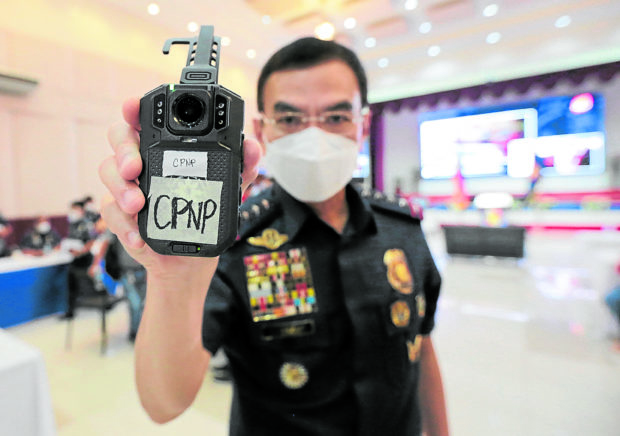
FILE – Philippine National Police (PNP) Chief Gen. Guillermo Eleazar shows the Body-Worn Camera System (BWCS) during its launching at a press conference on June 4, 2021, at Camp Crame in Quezon City./ GRIG C. MONTEGRANDE
MANILA, Philippines — The Philippine National Police (PNP) has been urged by senators to sit down with the Supreme Court (SC) again to clarify several matters regarding the use of body-worn cameras, as the police force currently cannot provide all offices with such gadgets.
During the deliberation of the Department of the Interior and Local Government (DILG) budget before the Senate finance committee on Tuesday, Senator Francis Tolentino said that PNP must talk with SC on what would be allowed as an alternative recording device in the absence of official body-worn cameras.
Prior to Tolentino’s suggestion, PNP chief Gen. Guillermo Eleazar admitted to Senator Ronald dela Rosa that only city police stations have received the body-worn cameras, as they only have 2,696 cameras or eight percent of the total requirement.
“Perhaps there is a need for the Philippine National Police to really sit down with the Supreme Court right now, and determine what is the meaning of these backup devices,” Tolentino said.
“Now they’re allowing probably, cellphone, gadgets to serve as a backup camera so there is a need to clarify all of these especially in the initial stages, considering the amount involved,” he added.
However, Tolentino also stressed that he supports the PNP’s move to provide body-worn cameras for officers conducting their operations.
Currently, Eleazar said that all 1,500 municipal police stations in the country do not have body-worn cameras.
“We seek your support, the Senate and the House of Representatives, kung pwedeng madagdagan ‘yong pondo sir, mabigyan kami (if you are able to increase the fund, please do so), so that we can procure more body-worn cameras and system to be distributed to other police units,” Eleazar said before he was questioned.
Tolentino’s concerns about what alternative recording device would be allowed came after Dela Rosa, who was once a PNP chief, asked whether police officers would still be able to enforce arrest and search orders if it does not adhere to the regulations set by SC.
In reply, Eleazar said that alternative recording devices were allowed.
“You should work on this dahil meron na ngang inissue ‘yong Supreme Court ‘di ba? Rule 2, Section 2 of the rules on the body-worn cameras in the execution of warrant states that the officers wearing the body-worn cameras shall notify the person to be arrested that execution of the warrant of arrest is being recorded,” Dela Rosa said.
“Kaya paano ‘yan, hindi na makapag-execute ng search warrant or makapag-implement ng warrant of arrest ‘yong ating mga municipal police stations dahil walang body-worn cameras?” he asked.
Committee chairperson and Senator Sonny Angara on the other hand asked whether the police really needed to buy systems for every set of cameras procured, as Eleazar said that each set worth P2 million contains 16 cameras and the system.
“But you need to buy that whole system? For every 16, you need a system, hindi ba pwedeng ‘yong camera lang ang bibilhin (wouldn’t it be better if we just bought the camera) once you have the system already?” Angara asked.
“Kasama sir ‘yon eh kasi pati ‘yong the police station itself, eh kasama na ‘yon, bale lumalabas na per system, consisting of the 16 units and all the accessories cost around P2 million,” Eleazar replied.
(It’s all included, sir, it doesn’t matter, it comes out according to the system. Even the police station itself is included.)
Last August, Eleazar also announced that the use of body-worn cameras is now mandatory after SC finally released its guidelines.
The body-worn cameras are seen to enhance the PNP’s capabilities, as well as erase doubts on questions surrounding the police operations on the drug war and the anti-insurgency campaign, where witnesses have claimed that police officers committed an abuse of authority.
READ: Using body-worn cameras now mandatory in PNP ops, Eleazar says
READ: SC vows ‘balanced’ rules on PNP use of body cameras

